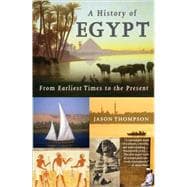
Note: Supplemental materials are not guaranteed with Rental or Used book purchases.
Purchase Benefits
| Acknowledgments | p. ix |
| Preface | p. x |
| Maps | p. xii |
| The Gift of the Nile | p. 1 |
| The Birth of Egyptian Civilization: Predynastic and Early Dynastic Egypt | p. 11 |
| The Old Kingdom | p. 25 |
| The First Intermediate Period and the Middle Kingdom | p. 43 |
| The Second Intermediate Period and the New Kingdom | p. 59 |
| The Third Intermediate Period and the Late Period | p. 83 |
| Ptolemaic Egypt | p. 97 |
| Egypt in the Roman Empire | p. 123 |
| Coptic Egypt | p. 145 |
| The Advent of Islam | p. 163 |
| The Fatimids and Ayyubids | p. 173 |
| The Mamluks | p. 189 |
| Egypt in the Ottoman Empire | p. 207 |
| The Birth of Modern Egypt | p. 219 |
| Mid-Nineteenth-Century Egypt | p. 235 |
| The British Occupation of Egypt | p. 253 |
| The Parliamentary Era | p. 273 |
| Nasser | p. 293 |
| Sadat | p. 317 |
| Mubarak and Beyond | p. 341 |
| Notes | p. 357 |
| Recommended Reading | p. 360 |
| Image Sources | p. 362 |
| Index | p. 363 |
| Table of Contents provided by Ingram. All Rights Reserved. |
The New copy of this book will include any supplemental materials advertised. Please check the title of the book to determine if it should include any access cards, study guides, lab manuals, CDs, etc.
The Used, Rental and eBook copies of this book are not guaranteed to include any supplemental materials. Typically, only the book itself is included. This is true even if the title states it includes any access cards, study guides, lab manuals, CDs, etc.
Excerpted from A History of Egypt: From Earliest Times to the Present by Jason Thompson
All rights reserved by the original copyright owners. Excerpts are provided for display purposes only and may not be reproduced, reprinted or distributed without the written permission of the publisher.